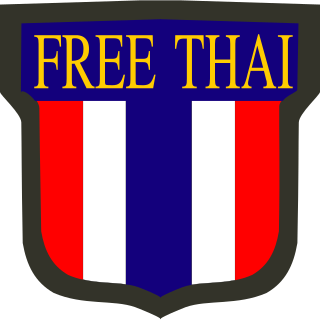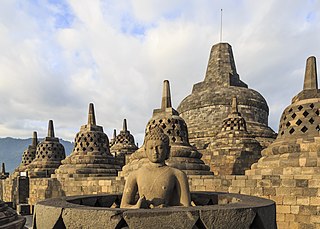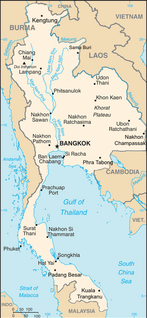Related Research Articles

Myanmar or Burma, officially the Republic of the Union of Myanmar, is a country in Southeast Asia. Myanmar is bordered by Bangladesh and India to its northwest, China to its northeast, Laos and Thailand to its east and southeast, and the Andaman Sea and the Bay of Bengal to its south and southwest. Myanmar is the largest country in Mainland Southeast Asia and the 10th largest in Asia by area. As of 2017, the population was about 54 million. Its capital city is Naypyidaw, and its largest city is Yangon (Rangoon).

Southeast Asia or Southeastern Asia is the geographical southeastern subregion of Asia, consisting of the regions that are south of China, southeast of the Indian subcontinent and north-west of Australia. Southeast Asia is bordered to the north by East Asia, to the west by South Asia and the Bay of Bengal, to the east by Oceania and the Pacific Ocean, and to the south by Australia and the Indian Ocean. Apart from the British Indian Ocean Territory and two out of 26 atolls of Maldives in South Asia, Southeast Asia is the only other subregion of Asia that lies partly within the Southern Hemisphere. The majority of the subregion is still in the Northern Hemisphere. East Timor and the southern portion of Indonesia are the only parts that are south of the Equator.

Thailand, formerly known as Siam, and officially the Kingdom of Thailand, is a country in Southeast Asia. It is located at the centre of the Indochinese Peninsula, spanning 513,120 square kilometres (198,120 sq mi), with a population of over 66 million people. Thailand is bordered to the north by Myanmar and Laos, to the east by Laos and Cambodia, to the south by the Gulf of Thailand and Malaysia, and to the west by the Andaman Sea and the southern extremity of Myanmar. It also shares maritime borders with Vietnam in the Gulf of Thailand to the southeast, and Indonesia and India on the Andaman Sea to the southwest. Bangkok is the nation's capital and largest city. Nominally, Thailand is a constitutional monarchy and parliamentary democracy; however, in recent history, its government has experienced multiple coups and periods of military dictatorships.

The Tai ethnic group migrated into mainland Southeast Asia over a period of centuries. The word Siam may have originated from Pali or Sanskrit श्याम or Mon ရာမည, probably the same root as Shan and Ahom. Chinese: 暹羅; pinyin: Xiānluó was the name for the northern kingdom centred on Sukhothai and Sawankhalok. To the Thai, the name has mostly been Mueang Thai.
The foreign relations of Thailand are handled by the Ministry of Foreign Affairs of Thailand.

The history of Southeast Asia covers the people of Southeast Asia from prehistory to the present in two distinct sub-regions: Mainland Southeast Asia and Maritime Southeast Asia. Mainland Southeast Asia comprises Cambodia, Laos, Myanmar, Peninsular Malaysia, Thailand and Vietnam whereas Maritime Southeast Asia comprises Brunei, Cocos (Keeling) Islands, Christmas Island, East Malaysia, East Timor, Indonesia, Philippines and Singapore.

Kriangsak Chamanan served as prime minister of Thailand from 1977 to 1980. After staging a successful coup, he was asked to become Prime Minister in 1977, he ruled till 1980 and is credited with "steering Thailand to democracy" in a time where internally, communist insurgents are rampant and neighbouring countries have turned to communist rule following the communist takeover of Vietnam: South Vietnam, Laos, and Cambodia. He died on 23 December 2003, aged 86.

Illegal logging is the harvest, transportation, purchase or sale of timber in violation of laws. The harvesting procedure itself may be illegal, including using corrupt means to gain access to forests; extraction without permission, or from a protected area; the cutting down of protected species; or the extraction of timber in excess of agreed limits. Illegal logging is a driving force for a number of environmental issues such as deforestation, soil erosion and biodiversity loss which can drive larger scale environmental crisis such as climate change and other forms of environmental degradation.

Free Thai Movement was a Thai underground resistance movement against Imperial Japan during World War II. Seri Thai were an important source of military intelligence for the Allies in the region.

The history of Thailand from 1973 to 2001 saw an unstable period of democracy, with military rule being reimposed after a bloody coup in 1976.

Thai Chinese are an ethnic Chinese community in Thailand. Thai Chinese are the largest minority group in the country and the largest overseas Chinese community in the world with a population of approximately 10 million people, accounting for 11–14% of the total population of the country as of 2012. It is also the oldest and most prominent integrated overseas Chinese community. Slightly more than half of the ethnic Chinese population in Thailand trace their ancestry to Chaoshan. This is evidenced by the prevalence of the Teochew dialect among the Chinese community in Thailand as well as other Chinese languages.

Nanyang is a sinocentric Chinese term for the warmer and fertile geographical region along the southern coastal regions of China and beyond, otherwise known as the 'South Sea' or Southeast Asia. The term came into common usage in self-reference to the large ethnic Chinese migrant population in Southeast Asia, and is contrasted with Xiyang, which refers to the Western world, Dongyang, which refers to East Asian cultural sphere and occasionally including the Greater India, and Beiyang, which refers to Russia. The Chinese press regularly uses the term to refer to the region stretching from Yunnan Province to Singapore and from Myanmar (Burma) to Vietnam ; in addition, the term also refers to Brunei, East Malaysia, East Timor, Indonesia and the Philippines in the region it encompasses.

Chatichai Choonhavan was a Thai army officer, diplomat and politician. From 1986 to 1991, he was the chairman of the Thai Nation Party and served as the Prime Minister of Thailand from August 1988 until the coup d'état of February 1991.

The military history of Thailand encompasses a thousand years of armed struggle, from wars of independence from the powerful Khmer Empire, through to struggles with her regional rivals of Burma and Vietnam and periods of tense standoff and conflict with the colonial empires of Britain and France. Thailand's military history, dominated by her centrality in the south-eastern Asian region, the significance of her far flung and often hostile terrain, and the changing nature of military technology, has had a decisive impact on the evolution of both Thailand and her neighbours as modern nation states. In the post-war era, Thailand's military relationship with the United States has seen her play an important role in both the Cold War and the recent War on Terror, whilst her military's involvement in domestic politics has brought frequent international attention.

The ASEAN Football Federation (AFF) is a smaller organisation within the greater Asian Football Confederation (AFC), and centres on Southeast Asia, founded in 1984 by the nations of Brunei, Indonesia, Malaysia, Philippines, Singapore and Thailand. ASEAN stands for Association of Southeast Asian Nations, although the AFF also includes Australia and East Timor, who are both currently not a part of the regional intergovernmental organization.
Foreign Aid to Thailand On July 31, 2003, Thailand repaid its outstanding obligations under a standby arrangement made with the International Monetary Fund designed to help it recover from the 1997 Asian Financial Crisis. The payment was made four years ahead of schedule, reflecting Thailand's achievement of macroeconomic and balance-of-payments stability.

Buddhism in Southeast Asia includes a variety of traditions of Buddhism including two main traditions: Mahāyāna Buddhism and Theravāda Buddhism. Historically, Mahāyāna Buddhism had a prominent position in this region, but in modern times most countries follow the Theravāda tradition. Southeast Asian countries with a Theravāda Buddhist majority are Thailand, Cambodia, Laos and Myanmar, all mainland countries.

Thailand in World War II officially adopted a position of neutrality until the five hour-long Japanese invasion of Thailand on 8 December 1941 which led to an armistice and military alliance treaty between Thailand and the Japanese Empire in mid-December 1941. At the start of the Pacific War, the Japanese Empire pressured the Thai government to allow the passage of Japanese troops to invade British-held Malaya and Burma. The Thai government under Plaek Phibunsongkhram considered it profitable to co-operate with the Japanese war efforts, since Thailand saw Japan – who promised to help Thailand regain some of the Indochinese territories which had been lost to France – as an ally against Western imperialism. Axis-aligned Thailand declared war on the United Kingdom and the United States and annexed territories in neighbouring countries, expanding to the north, south, and east, gaining a border with China near Kengtung.

The 1962 Burmese coup d'état on 2 March 1962 marked the beginning of one-party rule and the political dominance of the army in Burma which spanned the course of 26 years. In the coup, the military replaced the civilian AFPFL-government, headed by Prime Minister U Nu, with the Union Revolutionary Council, Chaired by General Ne Win.
Military build-up in Southeast Asia has been a noticeable trend, as shown by force modernization, although there is not necessarily political will to improve military effectiveness. The phenomenon has been attributed to various factors, including protecting economic interest, self-reliance in the reduction of US commitment in the region, domestic and foreign tensions, and the need to replace colonial era material, but also some non-military related factors such as national prestige, political corruption, etc.
References
- ↑ Kwok, Jia-Chuan (2010). Explaining Civil-Military Relations in Southeast Asia. Cambridge: Massachusetts Institute of Technology. p. 10.
- ↑ Harisanto, Eddy (1993). The Dual Function of the Indonesian Armed Forces. Monterey: Naval Postgraduate Institute. p. 69.
- ↑ Callahan, Mary. Burma: Soldiers as State Builders. Coercion and Governance: The Declining Political Role of the Military in Asia. p. 428.
- ↑ Harisanto, Eddy (1993). The Dual Function of the Indonesian Armed Forces. Monterey: Naval Postgraduate Institute. p. 29.
- ↑ Kwok, Jia-Chuan (2010). Explaining Civil-Military Relations in Southeast Asia. Cambridge: Massachusetts Institute of Technology. p. 54.
- ↑ Vaswani, Karishna (1 December 2010). "Indonesia's Army 'Retains Business Empire'". BBC News. Retrieved 25 April 2014.
- ↑ Hoadley, Stephen (1975). The Military in the Politics in Southeast Asia. Cambridge: Massachusetts Institute of Technology. p. 67.
- ↑ Hoadley, Stephen (1975). The Military in the Politics in Southeast Asia. Cambridge: Shenckman. p. 73.
- ↑ Brömmelhörster, Jörn (2003). The Military As An Economic Actor: Soldiers in Business. New York: Palgrave Macmillan. p. 75.
- ↑ Brömmelhörster, Jörn (2003). The Military as an Economic Actor: Soldiers in Business. New York: Palgrave Macmillan. p. 82.
- ↑ Kwok, Jia-Chuan (2010). Explaining Civil-Military Relations in Southeast Asia. Cambridge: Massachusetts Institute of Technology. p. 69.
- ↑ Brömmelhörster, Jörn (2003). The Military as an Economic Actor: Soldiers in Business. New York: Palgrave Macmillan. p. 84.
- ↑ Hoadley, Stephen (1975). The Military in the Politics of Southeast Asia. Cambridge: Schenkman. p. 43.
- ↑ Callahan, Mary. Burma: Soldiers as State Builders. Coercion and Governance: The Declining Political Role of the Military in Asia. p. 414.
- ↑ Kwok, Jia-Chuan (2010). Explaining Civil-Military Relations in Southeast Asia. Cambridge: Massachusetts Institute of Technology. p. 65.
- ↑ Huxley, Tim (2000). Defending the Lion City: The Armed Forces of Singapore. St Leonards: N.S.W.: Allen & Unwin. p. 2.
- ↑ Kwok, Jia-Chuan (2010). Explaining Civil-Military Relations in Southeast Asia. Cambridge: Massachusetts Institute of Technology. p. 56.
- ↑ "What is Total Defence" . Retrieved 26 April 2014.
- ↑ Hoadley, Stephen (1975). The Military in the Politics in Southeast Asia. Cambridge: Schenkman. p. 11.
- ↑ Hoadley, Stephen (1975). The Military in the Politics in Southeast Asia. Cambridge: Schenkman. p. 14.
- ↑ Hoadley, Stephen (1975). The Military in the Politics of Southeast Asia. Cambridge: Schenkman. p. 18.
- ↑ Kwok, Jia-Chuan (2010). Explaining Civil-Military Relations in Southeast Asia. Cambridge: Massachusetts Institute of Technology. p. 47.
- ↑ Kwok, Jia-Chuan (2010). Explaining Civil-Military Relations in Southeast Asia. Cambridge: Massachusetts Institute of Technology. p. 48.
- ↑ Hoadley, Stephen (1975). The Military in the Politics in Southeast Asia. Cambridge: Schenkman. p. 130.
- ↑ Hoadley, Stephen (1975). The Military in the Politics in Southeast Asia. Cambridge: Schenkman. p. 142.
- ↑ "Unkept Promise: Failure to End Military Business Activity in Indonesia" (PDF). Human Rights Watch. Retrieved 26 April 2014.
- ↑ Vaswani, Karishna (1 Dec 2010). "Indonesia's Army 'Retains Business Empire'". BBC News. Retrieved 25 April 2016.
- ↑ Brömmelhörster, Jörn (2003). The Military as an Economic Actor: Soldiers in Business. New York: Palgrave Macmillan. p. 76.
- ↑ Brömmelhörster, Jörn (2003). The Military as an Economic Actor: Soldiers in Business. New York: Palgrave Macmillan. p. 77.
- ↑ Brömmelhörster, Jörn (2003). The Military as an Economic Actor: Soldiers in Business. New York: Palgrave Macmillan. p. 81.
- ↑ Hoadley, Stephen (1975). The Military in the Politics in Southeast Asia. Cambridge: Schenkman. p. 208.